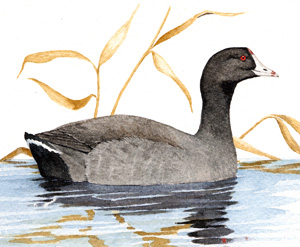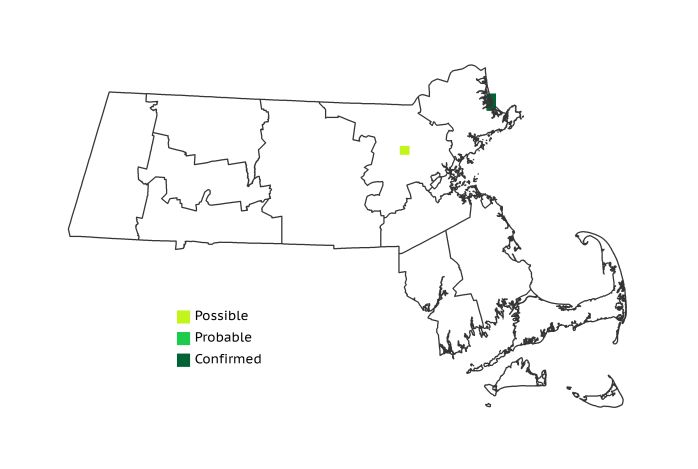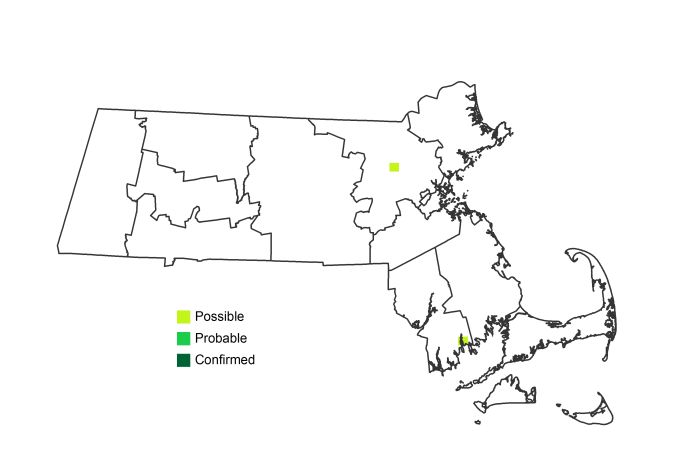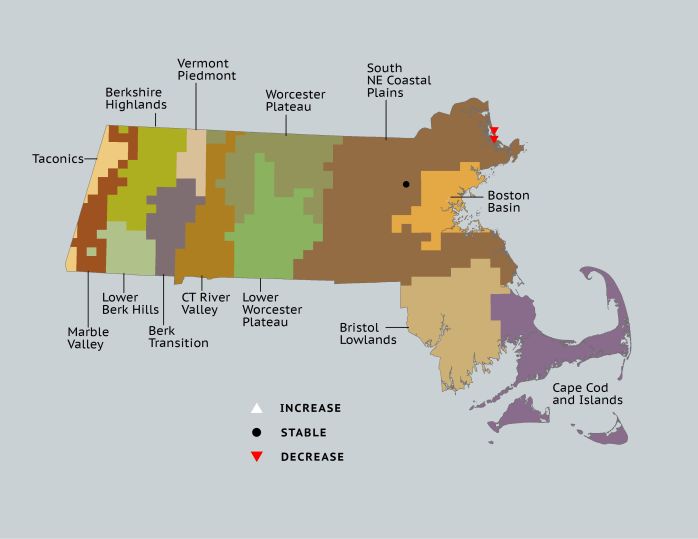Breeding Bird Atlases (BBA)
Find a Bird
American Coot
Fulica americana

Very local, trend not established
“I come from haunts of coot and hern, / I make a sudden sally / And sparkle out among the fern, / To bicker down a valley.” – Alfred Lord Tennyson, “The Brook”
Easily the most familiar member of the family Rallidae, American Coots are a common sight in Massachusetts during the fall migration, when rafts of birds numbering in the hundreds can sometimes be seen feeding together on aquatic vegetation. However, as a breeding species, the American Coot is primarily western and southern in distribution. Its history in Massachusetts is one of brief expansions and prolonged absences – a pattern borne out by its limited presence during the Atlas surveys.
Historic Status
The great ornithologist Thomas Nuttall claimed to have seen American Coots – meaning a single pair – breeding on Fresh Pond in Cambridge in the early 1800s, but no nest was ever located (Nuttall 1834). Widespread and popular among sportsmen, they became an easy target for gunners when waterfowl stocks declined in the late 1800s. Forbush estimated their slaughter in the millions annually at the beginning of the twentieth century, stating that “fried coot” was never considered a delicacy but was never pushed away from the table either (Forbush 1925). Nationwide, the population declined during the 1900s, yet the American Coot moved into Massachusetts as a definite breeder late in that century.
Atlas 1 Distribution
Though its past in the state may have been somewhat obscure, the picture of American Coot breeding distribution during Atlas 1 was quite clear, and quite limited. From the late 1960s onward, American Coots continued to breed at Parker River National Wildlife Refuge in freshwater marsh areas. Coots were also spotted during the summer at Great Meadows National Wildlife Refuge in Concord, another locality where they had bred in the past. Unfortunately, no conclusive proof of nesting was discovered at that location during the Atlas period.
Atlas 2 Distribution and Change
American Coot breeding activity slowed to a near halt in Massachusetts between Atlas 1 and Atlas 2. No Confirmations or signs of breeding coots of any sort came from Plum Island. Although there was a single Possible record from Great Meadows, American Coots were essentially absent from Massachusetts as a breeding species in Atlas 2. It is not uncommon for a pioneering species to advance and retreat from breeding range expansions. The disappearance of breeding coots from Massachusetts is not necessarily catastrophic, positioned as we are at the very edge of the species’ breeding range. However, when viewed through the lens of the other species that share their wetland habitat, which are also declining, it is one more potential indicator of troubling habitat issues.
Atlas 1 Map

Atlas 2 Map

Atlas Change Map

Ecoregion Data
Atlas 1 | Atlas 2 | Change | ||||||
Ecoregion | # Blocks | % Blocks | % of Range | # Blocks | % Blocks | % of Range | Change in # Blocks | Change in % Blocks |
Taconic Mountains | 0 | 0.0 | 0.0 | 0 | 0.0 | 0.0 | 0 | 0.0 |
Marble Valleys/Housatonic Valley | 0 | 0.0 | 0.0 | 0 | 0.0 | 0.0 | 0 | 0.0 |
Berkshire Highlands | 0 | 0.0 | 0.0 | 0 | 0.0 | 0.0 | 0 | 0.0 |
Lower Berkshire Hills | 0 | 0.0 | 0.0 | 0 | 0.0 | 0.0 | 0 | 0.0 |
Vermont Piedmont | 0 | 0.0 | 0.0 | 0 | 0.0 | 0.0 | 0 | 0.0 |
Berkshire Transition | 0 | 0.0 | 0.0 | 0 | 0.0 | 0.0 | 0 | 0.0 |
Connecticut River Valley | 0 | 0.0 | 0.0 | 0 | 0.0 | 0.0 | 0 | 0.0 |
Worcester Plateau | 0 | 0.0 | 0.0 | 0 | 0.0 | 0.0 | 0 | 0.0 |
Lower Worcester Plateau | 0 | 0.0 | 0.0 | 0 | 0.0 | 0.0 | 0 | 0.0 |
S. New England Coastal Plains and Hills | 3 | 1.1 | 100.0 | 1 | 0.4 | 50.0 | -2 | -0.9 |
Boston Basin | 0 | 0.0 | 0.0 | 0 | 0.0 | 0.0 | 0 | 0.0 |
Bristol and Narragansett Lowlands | 0 | 0.0 | 0.0 | 1 | 0.9 | 50.0 | 0 | 0.0 |
Cape Cod and Islands | 0 | 0.0 | 0.0 | 0 | 0.0 | 0.0 | 0 | 0.0 |
Statewide Total | 3 | 0.3 | 100.0 | 2 | 0.2 | 100.0 | -2 | -0.2 |



